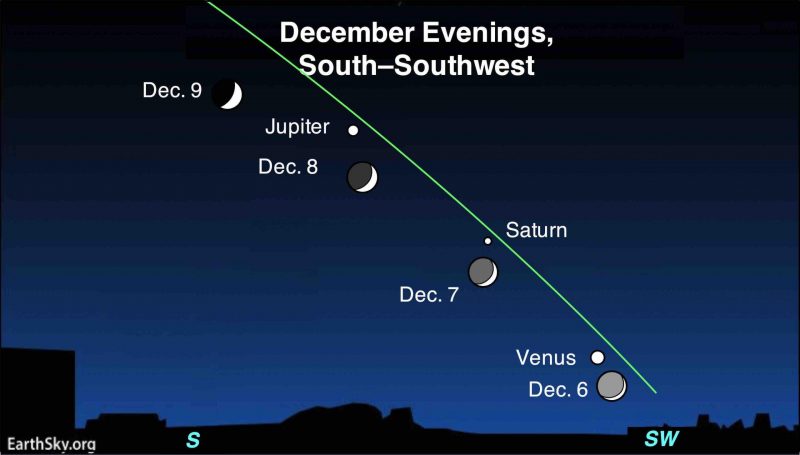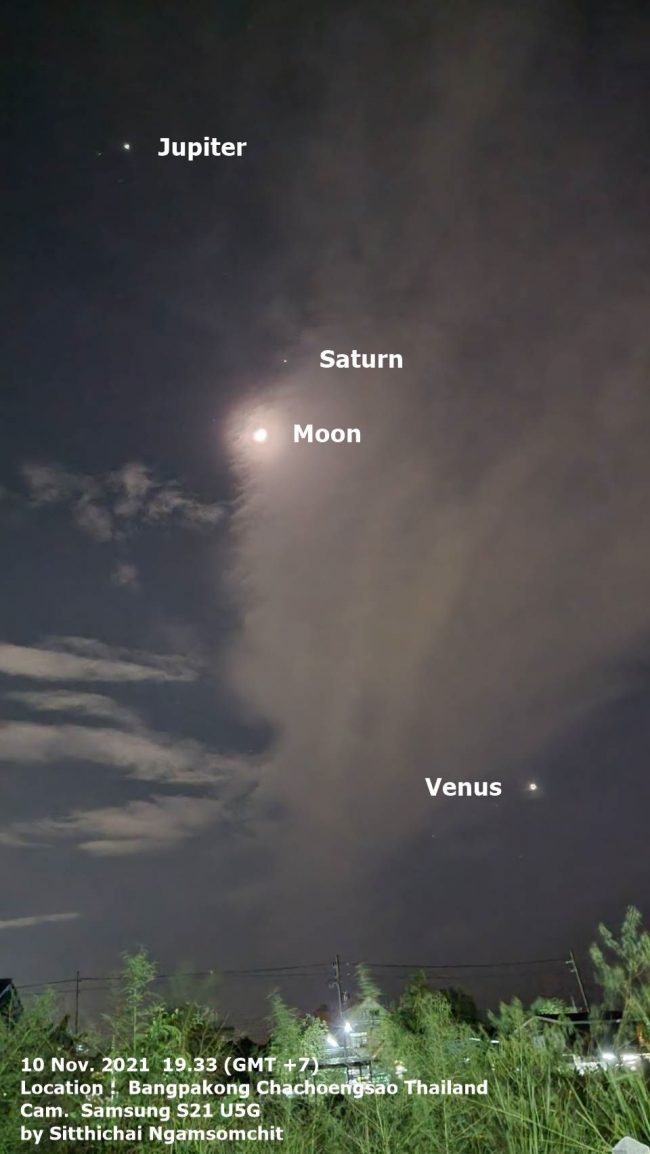
Moon, Jupiter, Saturn, Venus
New moon came at 07:43 UTC on December 4, 2021. By the evening of December 6, the young waxing crescent is back in the evening sky. From that evening through at least the evening of December 9, you can see spectacularly beautiful scenes in the sky after sunset, as the moon sweeps up away from the sun in our sky, passing first Venus, then Saturn, then Jupiter. Two of these (Venus and Jupiter) are the brightest planets. They’ll be incredibly noticeable with the moon!
And the moon itself, softly glowing with earthshine, will be showing mysterious markings on its night side.
Venus is super bright
Venus has been sliding sunward since its late October greatest elongation, and that’ll continue throughout December 2021. In other words, Venus drops closer to the sunset point as western twilight darkens each day. The planet is easy to spot at the beginning of the month. It’s the brightest planet and brightest starlike object in the sky after sunset.
But Venus proves more difficult to spot near month’s end as it gets closer to the sunset, appears in brighter twilight, and sets sooner behind the sun. Where’s Venus going? It’s about to move between the Earth and sun in its smaller, faster orbit. It’ll be nearest the Earth-sun line – at inferior conjunction – on January 9, 2022.
Since Venus is slowly passing Earth this month, on the inside track around the sun, it presents a host of interesting observing possibilities. On December 3, Venus reached its greatest illuminated extent. That’s when the lighted portion of the planet visible from Earth – the crescent Venus, seen through telescopes now – covers its greatest area on our sky’s dome. And it’s around this time that astronomers say Venus appears at greatest brilliancy. If you’ve glimpsed Venus lately, you know it has been looking very eerie throughout late November and early December. It’ll be shining so brightly, so near the sunset point, that many will report it as a UFO!
As the month progresses, the disk of Venus facing Earth will grow in size as the distance between our two worlds decreases. But we’ll see less and less of Venus’ lighted half, or day side. In other words, as the overall size of the crescent grows larger, the crescent itself will wane in phase. And that makes December 2021 the best time to view Venus with common, household binoculars (or a telescope). Place binoculars on a steady support such as a tripod (you can also hold them, and brace your elbows on a fence rail or your knees). Then sharply focus them. The planet will show itself as a tiny, thin crescent with the tips (or horns) of the crescent pointing away from the sunset point. Tip: If the cloud-covered Venus is too bright through your binoculars – and if it dazzles your eyes – try wearing sunglasses. Yes, sunglasses!

Jupiter and Saturn: also noticeable
Jupiter is the second-brightest starlike object in the December evening sky (only Venus appears as a brighter “star”). Jupiter has been traveling near fainter Saturn throughout 2021, but now – as the year ends – brilliant Jupiter and Saturn are like bookends for Saturn. The three planets are evenly spaced and very noticeable.
It’s as if they’re on a celestial string. And indeed we astronomers call this imaginary string across our sky the ecliptic. It’s really the flat plane of our solar system, the plane in which all the major planets – and, for the most part, their moons – travel around the sun.
On December 6, 7, 8, and 9, 2021, the moon scoots along that string, first passing Venus, then Saturn, then Jupiter. A fascinating sight!

What next for Jupiter, Saturn, Venus?
Throughout December, all three planets are sliding together toward the setting sun. We mentioned above that Venus will pass between the sun and Earth on January 9, 2022. So Venus will soon disappear. But Jupiter and Saturn have big, huge orbits, much wider than Earth’s. They can’t go between us and the sun, but instead are aiming now toward the far side of the sun from Earth. And they’ll still be around – briefly, not far from the sunset – when 2022 begins. Then both will drop into the sun’s glare, with Saturn disappearing first. Saturn will reach its superior conjunction on February 4, 2022. Jupiter will reach its superior conjunction on March 5, 2022. Those are the dates when these worlds will be most directly behind the sun. Afterwards, both planets will return to the east before dawn to begin another cycle of visibility in our sky.
In 2022, Saturn will reach its opposition – when Earth passes between it and the sun – on August 14. Jupiter’s opposition will come on September 26.
Bottom line: Wow! What a sight. The moon, Jupiter, Saturn, Venus all in your western sky after sunset. Watch for them December 6 to 9, 2021.
Planet-observing is easy: Top tips here
EarthSky’s monthly planet guide: Visible planets and more
The post Moon, Jupiter, Saturn, Venus December 6 to December 9 first appeared on EarthSky.
from EarthSky https://ift.tt/31wPk5o

Moon, Jupiter, Saturn, Venus
New moon came at 07:43 UTC on December 4, 2021. By the evening of December 6, the young waxing crescent is back in the evening sky. From that evening through at least the evening of December 9, you can see spectacularly beautiful scenes in the sky after sunset, as the moon sweeps up away from the sun in our sky, passing first Venus, then Saturn, then Jupiter. Two of these (Venus and Jupiter) are the brightest planets. They’ll be incredibly noticeable with the moon!
And the moon itself, softly glowing with earthshine, will be showing mysterious markings on its night side.
Venus is super bright
Venus has been sliding sunward since its late October greatest elongation, and that’ll continue throughout December 2021. In other words, Venus drops closer to the sunset point as western twilight darkens each day. The planet is easy to spot at the beginning of the month. It’s the brightest planet and brightest starlike object in the sky after sunset.
But Venus proves more difficult to spot near month’s end as it gets closer to the sunset, appears in brighter twilight, and sets sooner behind the sun. Where’s Venus going? It’s about to move between the Earth and sun in its smaller, faster orbit. It’ll be nearest the Earth-sun line – at inferior conjunction – on January 9, 2022.
Since Venus is slowly passing Earth this month, on the inside track around the sun, it presents a host of interesting observing possibilities. On December 3, Venus reached its greatest illuminated extent. That’s when the lighted portion of the planet visible from Earth – the crescent Venus, seen through telescopes now – covers its greatest area on our sky’s dome. And it’s around this time that astronomers say Venus appears at greatest brilliancy. If you’ve glimpsed Venus lately, you know it has been looking very eerie throughout late November and early December. It’ll be shining so brightly, so near the sunset point, that many will report it as a UFO!
As the month progresses, the disk of Venus facing Earth will grow in size as the distance between our two worlds decreases. But we’ll see less and less of Venus’ lighted half, or day side. In other words, as the overall size of the crescent grows larger, the crescent itself will wane in phase. And that makes December 2021 the best time to view Venus with common, household binoculars (or a telescope). Place binoculars on a steady support such as a tripod (you can also hold them, and brace your elbows on a fence rail or your knees). Then sharply focus them. The planet will show itself as a tiny, thin crescent with the tips (or horns) of the crescent pointing away from the sunset point. Tip: If the cloud-covered Venus is too bright through your binoculars – and if it dazzles your eyes – try wearing sunglasses. Yes, sunglasses!

Jupiter and Saturn: also noticeable
Jupiter is the second-brightest starlike object in the December evening sky (only Venus appears as a brighter “star”). Jupiter has been traveling near fainter Saturn throughout 2021, but now – as the year ends – brilliant Jupiter and Saturn are like bookends for Saturn. The three planets are evenly spaced and very noticeable.
It’s as if they’re on a celestial string. And indeed we astronomers call this imaginary string across our sky the ecliptic. It’s really the flat plane of our solar system, the plane in which all the major planets – and, for the most part, their moons – travel around the sun.
On December 6, 7, 8, and 9, 2021, the moon scoots along that string, first passing Venus, then Saturn, then Jupiter. A fascinating sight!

What next for Jupiter, Saturn, Venus?
Throughout December, all three planets are sliding together toward the setting sun. We mentioned above that Venus will pass between the sun and Earth on January 9, 2022. So Venus will soon disappear. But Jupiter and Saturn have big, huge orbits, much wider than Earth’s. They can’t go between us and the sun, but instead are aiming now toward the far side of the sun from Earth. And they’ll still be around – briefly, not far from the sunset – when 2022 begins. Then both will drop into the sun’s glare, with Saturn disappearing first. Saturn will reach its superior conjunction on February 4, 2022. Jupiter will reach its superior conjunction on March 5, 2022. Those are the dates when these worlds will be most directly behind the sun. Afterwards, both planets will return to the east before dawn to begin another cycle of visibility in our sky.
In 2022, Saturn will reach its opposition – when Earth passes between it and the sun – on August 14. Jupiter’s opposition will come on September 26.
Bottom line: Wow! What a sight. The moon, Jupiter, Saturn, Venus all in your western sky after sunset. Watch for them December 6 to 9, 2021.
Planet-observing is easy: Top tips here
EarthSky’s monthly planet guide: Visible planets and more
The post Moon, Jupiter, Saturn, Venus December 6 to December 9 first appeared on EarthSky.
from EarthSky https://ift.tt/31wPk5o

Aucun commentaire:
Enregistrer un commentaire